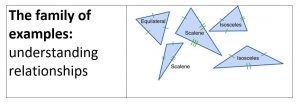
November 17, 2021, by Rupert Knight
A change of perspective: the explanatory power of varied examples
In this post, Rupert Knight considers how drawing on varied examples when explaining new concepts can enhance understanding.
It builds on previous blogs in this series, particularly those on a teacher’s core practices and on modelling.
Showing the essence of an idea through multiple perspectives
‘Jim Jarvis hopped about on the edge of the road, his feet blue with cold. Passing carriages flung muddy snow up into his face and eyes, and the swaying horses slithered and skidded as they were whipped on by their drivers. At last Jim saw his chance and made a dash for it through the traffic. The little shops in the dark street all glowed yellow with their hanging lamps, and Jim dodged from one light to the next until he came to the shop he was looking for. It was the meat pudding shop. Hungry boys and skinny dogs hovered round the doorway, watching for scraps. Jim pushed past them, his coin as hot as a piece of coal in his fist.’ (Doherty, 1993).
This vivid opener from Berlie Doherty’s ‘Street Child’ illustrates the old maxim for the storyteller of ‘show, don’t tell’. In this brief passage, we are shown the essence of the protagonist through a well-sequenced combination of clues that take us on a journey across the street with Jim (the indicators of poverty and period detail setting the scene, before aspects of character are revealed). When we think about explaining new ideas to children in primary classrooms, we can think in a similar way about conveying the essence of a concept through careful sequencing of well-chosen examples for specific purposes.
Building understanding through examples
Explaining has been defined as making something ‘clear or easy to understand by describing or giving information about it’. David Perkins differentiates understanding from knowledge: in contrast to knowledge, described as ‘information on tap’, he characterises understanding as an ability to ‘think and act flexibly with what one knows.’ If thinking and acting flexibility, or applying knowledge in unfamiliar contexts, are indicators of understanding, then a secure grasp of the boundaries of a concept is essential. This is why explanations which draw on multiple examples in specific ways and ‘test’ these parameters may be particularly powerful.
While there are many facets to explaining concepts, as summarised in this blog by Tom Sherrington, the focus here is therefore specifically on how the thoughtful selection and combination of examples can aid understanding.
Considering a range of example types
For the sake of clarity, let’s consider the idea of a variety of example types using the familiar concept of a triangle in mathematics. Eleven categories of example are presented below, but perhaps you would suggest others to add to the list.











Combining different types of example for different purposes
Each type of example potentially aids the understanding of a particular aspect of the concept, so examples can be combined in different ways for specific effects. Consider the following four sequences based on the table above and the purposes they could serve:
1. Archetypal example ➜ contrasting / atypical examples ➜ near / non-examples
This first sequence might work well as a straightforward teacher-led exposition. There is a gradual move from simplicity to complexity through refining the definition of a triangle and thereby clarifying the conceptual boundaries.
2. Archetypal example ➜ elaborated example ➜ family of examples➜ contrasting examples
Sequence Two is about relationships. In this scenario, triangles are understood in a generic way but pupils now consider a specific type (e.g. isosceles), its relationship to other types in the ‘family’ and the features that signify its categorisation.
3. Everyday example ➜ example in action ➜ elaborated example
This time, the focus is on applied understanding by deconstructing an everyday example. Beginning with where triangles might be encountered, the explanation moves towards their function and the specific properties that make triangles appropriate for this role.
4. Controversial example ➜ near example ➜ atypical example ➜ Archetypal example
Sequence Four almost inverts Sequence One by working from uncertainty to clarity and could lend itself to a form of explanation involving pupils in ‘Socratic’ dialogue which gradually probes and refines their understanding.
In each case, it is the variation and juxtaposition of examples that illuminates particular facets of the concept. The way that teachers might then work with any chosen example as a representation or model is a topic in its own right (discussed in detail in a mathematical context in a blog by Marc North), but thinking about the implications and impact of differing combinations of example in this way might be a useful starting point.
Taking this further
If choice and sequencing of examples is potentially powerful, it is also pedagogically complex, so questions to consider might include:
• How can this principle be applied to other concepts across the curriculum?
• Do different curriculum areas tend to draw on different types and sequences of example?
• Does the choice of examples depend on where in a sequence of learning an explanation is used?
It would be interesting to hear your thoughts and experiences!
Reference:
Doherty, B. (1993) Street Child, London: Harper Collins
No comments yet, fill out a comment to be the first

Leave a Reply